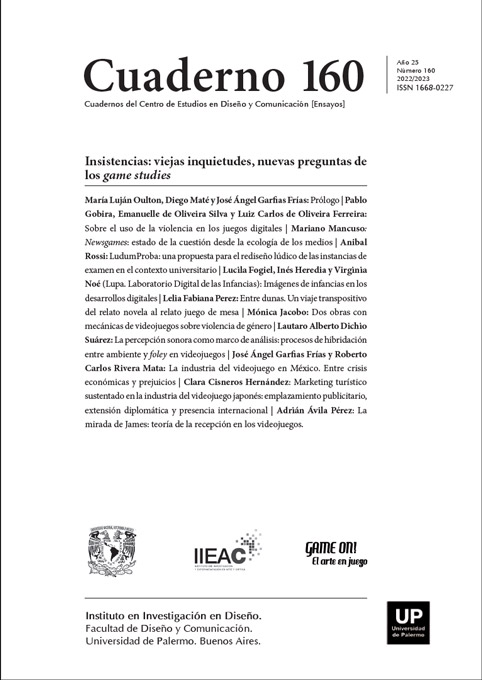La percepción sonora como marco de análisis: procesos de hibridación entre ambiente y foley en videojuegos
Abstract
The ludomusicological bibliography focuses on the study of music, but there is still no clear field of analysis of the other sound elements that make up sound design. The work has as its axis the exploration of the perceptual processes that occur between these elements. Based on the phenomenon of interchange, which is the exchange among two elements of use or meaning for that of the other, the concept of sound hybrid was elaborated, from which an analysis tool was developed to study the combinations between two sound elements. Any; in this study, the combination between ambient and foley. The interrelation of ambient and foley can be explained by the principles of Gestalt theory applied to sound. It is concluded that the concept of the sound hybrid enables a new way of interpreting the construction of virtual sound spaces, and also that they can help in the narrative, mechanics and design of the game.
References
Adaso, H. (30 de marzo de 2019). What Is Gangsta Rap? live about. https://www.liveabout.com/what-is-gangsta-rap-2857307
Altozano, J. (23 de abril de 2020). La identidad en GTA San Andreas [Análisis] - Post Script. Canal de YouTube DayoScript. https://www.youtube.com/watch?v=s-aph61W300&ab_channel=DayoScript
Bernstein, D. (14 de noviembre de 1997). Creating an Interactive Audio Environment. Gamasutra. https://www.gamasutra.com/view/feature/131646/creating_an_interactive_audio_.php
Branigan, E. (1992). Narrative Comprehension and Film. Routledge.
Chattopadhyay, B. (2016). Making Sites Audible: Ambient Sound in Practice. Sonologia, 99-110.
Childs, G. (2007). Creating Music and Sound for Games. Course Technology.
Collins, K. (2008). An Introduction to the history, theory, and practice of video game music and sound design. MIT Press.
Creative Media Design. (2021). Game Audio: Video Game Sound Design. Creative Media Design. https://www.cmdnyc.com/game-audio
Dichio Suárez, L. A. (2021). Hibridación ambiente-foley en el marco de los videojuegos de tres dimensiones y realidad virtual [Tesis de Grado de la Universidad Nacional de Quilmes].
Elferen, I. v. (2020). Ludomusicology and the new drastic. Journal of Sound and Music in Games, 103-112.
Fernández-Cortez, J. P. (2020). Ludomusicología: normalizando el estudio de la música de los videojuegos. Anuario Musical, 75. 181-199.
Gallego, G. P. (2019). Conceptualización de la terminología ludomusicológica. Revista de Investigacion Musical: Territorios para el arte. 57-68.
Huerter, M. (2019). Is This My Story? Is This My Song? Exploring Narrative Dissonance in Worship Music Through the Lens of Ludomusicology. Baylor University.
Huizinga, J. (2020). Intento de delimitación del elemento lúdico en la cultura. Espíritu Guerrero.
Iantorno, S. M., & Mony, M. (2020). GameSound, Quantitative Games Analysis, and the Digital Humanities. Digital Studies/Le champ numérique 10, 1-17.
Jorgensen, K. (2006). On The functional aspects of computer game audio. University of Bergen.
Jorgensen, K. (2008). Audio and Gameplay: An Analysis of PvP Battlegrounds in World of Warcraft. Game Studies, 8, 2.
Jorgensen, K. (2011). Time for New Terminology? Diegetic and Non-Diegetic Sounds in Computer. En M. Grimshaw, Game Sound Technology and Player Interaction: Concepts and Developments. University of Bolton. 78-97.
Juan Pablo Fernández-Cortés. (13 de 04 de 2018). Ludomusicología. “¿Qué es la ludomusicología?”: https://ludomusico.hypotheses.org/1.
Levinson, J. (1984). Hybrid Art Forms. The Journal of Aesthetic Education, 18, 4. 5-12.
Marc D. Binder, N. H. (2009). Encyclopedia of Neuroscience. Springer Berlin.
Mäyrä, F., & Ermi, L. (2005). Fundamental Components of the Gameplay. Proceedings of DiGRA 2005 Conference: Changing Views – Worlds in Play.
Moseley, R. (2013). Playing Games with Music (and Vice Versa): Ludomusicological Perspectives on Guitar Hero and Rock Band. En C. N., & P. R., Taking it to the bridge: music as performance. University of Michigan Press. 279-318
Murch, W. (2005). Dense Clarity – Clear Density.
Phillips, W. (2014). A composer’s Guide to Game Music. The MIT Press.
Schmidt, U. (2013). Ambience and Ubiquity. En U. Schmidt, Throughout: Art and Culture Emerging with Ubiquitous Computing. The MIT Press.175-187
Soro, E. S., Nuñez, M. M., & Gual, I. B. (2011). Del Cine Al Videojuego ¿Evolución, simbiosis o parasitismo? Universitat Jaume I.
Sutojo, S., Thiemann, J., Kohlrausch, A., & Par., S. v. (2020). Auditory Gestalt Rules and Their Application. En J. B. Braasch, The Technology of Binaural Understanding. The ASA Press. 33-59
Wertheimer, M. (1923). Untersuchungen zur Lehre von der Gestalt. II. Psychologische Forschung. 301–350.
Los autores/as que publiquen en esta revista ceden los derechos de autor y de publicación a "Cuadernos del Centro de Estudios de Diseño y Comunicación", Aceptando el registro de su trabajo bajo una licencia de atribución de Creative Commons, que permite a terceros utilizar lo publicado siempre que de el crédito pertinente a los autores y a esta revista.


